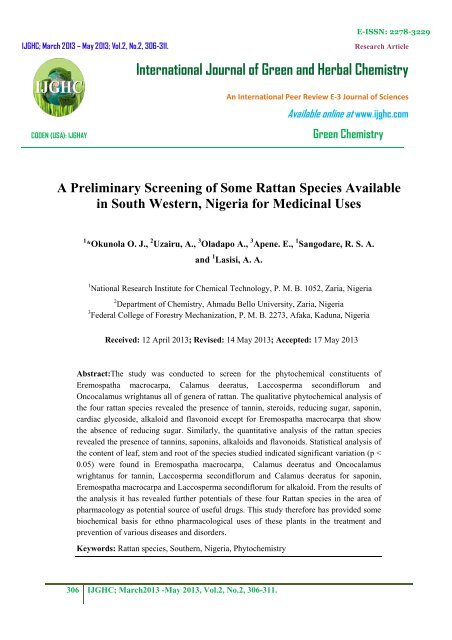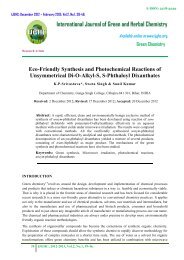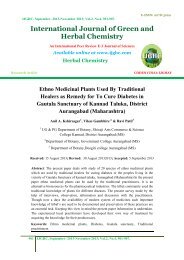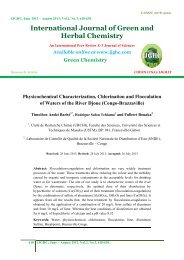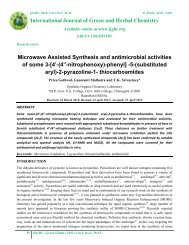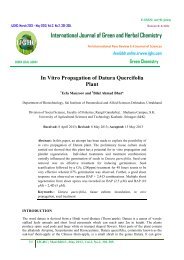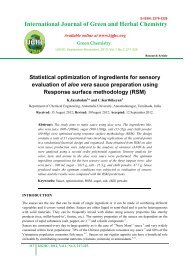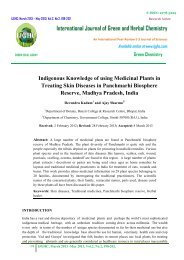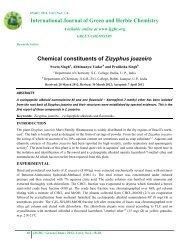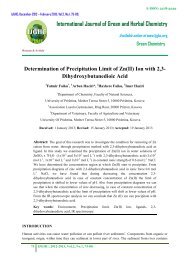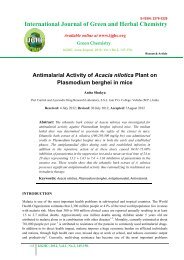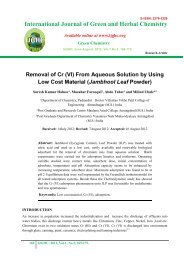International Journal of Green and Herbal Chemistry - IJGHC
International Journal of Green and Herbal Chemistry - IJGHC
International Journal of Green and Herbal Chemistry - IJGHC
Create successful ePaper yourself
Turn your PDF publications into a flip-book with our unique Google optimized e-Paper software.
<strong>IJGHC</strong>; March 2013 – May 2013; Vol.2, No.2, 306-311.<br />
E-ISSN: 2278-3229<br />
Research Article<br />
<strong>International</strong> <strong>Journal</strong> <strong>of</strong> <strong>Green</strong> <strong>and</strong> <strong>Herbal</strong> <strong>Chemistry</strong><br />
CODEN (USA): IJGHAY<br />
An <strong>International</strong> Peer Review E-3 <strong>Journal</strong> <strong>of</strong> Sciences<br />
Available online at www.ijghc.com<br />
<strong>Green</strong> <strong>Chemistry</strong><br />
A Preliminary Screening <strong>of</strong> Some Rattan Species Available<br />
in South Western, Nigeria for Medicinal Uses<br />
1 *Okunola O. J., 2 Uzairu, A., 3 Oladapo A., 3 Apene. E., 1 Sangodare, R. S. A.<br />
<strong>and</strong> 1 Lasisi, A. A.<br />
1 National Research Institute for Chemical Technology, P. M. B. 1052, Zaria, Nigeria<br />
2 Department <strong>of</strong> <strong>Chemistry</strong>, Ahmadu Bello University, Zaria, Nigeria<br />
3 Federal College <strong>of</strong> Forestry Mechanization, P. M. B. 2273, Afaka, Kaduna, Nigeria<br />
Received: 12 April 2013; Revised: 14 May 2013; Accepted: 17 May 2013<br />
Abstract:The study was conducted to screen for the phytochemical constituents <strong>of</strong><br />
Eremospatha macrocarpa, Calamus deeratus, Laccosperma secondiflorum <strong>and</strong><br />
Oncocalamus wrightanus all <strong>of</strong> genera <strong>of</strong> rattan. The qualitative phytochemical analysis <strong>of</strong><br />
the four rattan species revealed the presence <strong>of</strong> tannin, steroids, reducing sugar, saponin,<br />
cardiac glycoside, alkaloid <strong>and</strong> flavonoid except for Eremospatha macrocarpa that show<br />
the absence <strong>of</strong> reducing sugar. Similarly, the quantitative analysis <strong>of</strong> the rattan species<br />
revealed the presence <strong>of</strong> tannins, saponins, alkaloids <strong>and</strong> flavonoids. Statistical analysis <strong>of</strong><br />
the content <strong>of</strong> leaf, stem <strong>and</strong> root <strong>of</strong> the species studied indicated significant variation (p <<br />
0.05) were found in Eremospatha macrocarpa, Calamus deeratus <strong>and</strong> Oncocalamus<br />
wrightanus for tannin, Laccosperma secondiflorum <strong>and</strong> Calamus deeratus for saponin,<br />
Eremospatha macrocarpa <strong>and</strong> Laccosperma secondiflorum for alkaloid. From the results <strong>of</strong><br />
the analysis it has revealed further potentials <strong>of</strong> these four Rattan species in the area <strong>of</strong><br />
pharmacology as potential source <strong>of</strong> useful drugs. This study therefore has provided some<br />
biochemical basis for ethno pharmacological uses <strong>of</strong> these plants in the treatment <strong>and</strong><br />
prevention <strong>of</strong> various diseases <strong>and</strong> disorders.<br />
Keywords: Rattan species, Southern, Nigeria, Phytochemistry<br />
306 <strong>IJGHC</strong>; March2013 -May 2013, Vol.2, No.2, 306-311.
A Preliminary<br />
Okunola O. J. et al.<br />
INTRODUCTION<br />
Rattans are climbing palms belonging to the Calamoideae, a large sub-family <strong>of</strong> the palm family (Palmae<br />
or Araceae). About 600 different species <strong>of</strong> rattan belonging to 13 genera are concentrated solely in the<br />
Old World tropics. They are characterized by overlapping refluxed scales on the fruit, <strong>and</strong> all are spiny, a<br />
necessary pre-adaptation to the climbing habit 1. Some species are shrubby palms <strong>of</strong> the forest undergrowth<br />
<strong>and</strong> do not climb; nevertheless, reproductive features link them with other species that are climbers, <strong>and</strong><br />
they are hence included in the rattan genera. Of the thirteen genera <strong>of</strong> rattan, four (Eremospatha, Calamus,<br />
Laccosperma <strong>and</strong> Oncocalamus) are endemic to Africa, particularly West Africa. Although, some <strong>of</strong> the<br />
species within these genera utilized locally for medicinal purposes <strong>and</strong> form the base <strong>of</strong> a thriving cottage<br />
industry, they have only recently begun to attract attention from commercial concerns 2 .<br />
From literature search, no scientific investigations have been conducted until date to screen these rattan<br />
species for possible medicinal use, hence, our decision to investigate the phytochemical constituents <strong>of</strong> the<br />
aqueous leaf, stem <strong>and</strong> root extract <strong>of</strong> the plant in this study.<br />
MATERIALS AND METHOD<br />
Collection <strong>of</strong> plant samples: The plant materials are collected from local area. Fresh leaves <strong>and</strong> roots are<br />
collected <strong>and</strong> shade dried under room temperature. The dried leaves <strong>and</strong> roots grained into a coarse<br />
powder. The dried powdered leaves <strong>and</strong> roots macerated by using mortar, pestle, <strong>and</strong> used for further<br />
investigations. The plants are processed <strong>and</strong> analyzed.<br />
Processing <strong>of</strong> plant samples: Fresh leaves <strong>and</strong> roots are collected <strong>and</strong> shade dried under room<br />
temperature. The dried leaves <strong>and</strong> roots are grained into a coarse powder The dried powdered leaves<br />
<strong>and</strong> roots were macerated by using mortar <strong>and</strong> pestle <strong>and</strong> used for further investigations. The plants are<br />
processed <strong>and</strong> analyzed. The leaves <strong>of</strong> the plants are properly washed in tap water <strong>and</strong> then rinsed in<br />
distilled water. The rinsed leaves dried in an oven at a temperature <strong>of</strong> 35°C for 3 days. The dried leaves <strong>of</strong><br />
each plant pulverized, using a sterile electric blender, to obtain a powered form. The powdered form <strong>of</strong><br />
these plants is stored in airtight glass containers, protected from sunlight until required for analysis.<br />
Preparation <strong>of</strong> aqueous extract <strong>of</strong> plant samples: The aqueous extract <strong>of</strong> each plant sample is prepared<br />
by soaking 10g <strong>of</strong> powdered samples in 200 ml <strong>of</strong> distilled water for 12h. The extracts are then filtered<br />
using filter paper or Whatman filter paper.<br />
Phytochemical analysis: Qualitative analyses such as tannins, phlobatannins, saponins, flavonoids,<br />
terpenoids, steroids, reducing sugar, alkaloid <strong>and</strong> cardiac glycosides <strong>and</strong> quantitative analyses are<br />
conducted on the aqueous extract <strong>of</strong> each plant sample <strong>and</strong> <strong>of</strong> the powdered form <strong>of</strong> the plant samples<br />
using methods according to Edeoga et al. 3<br />
RESULTS<br />
Qualitative analysis: The phytochemical screening <strong>of</strong> the plants studied as summarized in Table 1 showed<br />
that the leaves stem <strong>and</strong> root were rich in tannin, steroids, reducing sugar, saponin, cardiac glycoside,<br />
alkaloid <strong>and</strong> flavonoid with exception <strong>of</strong> Eremospatha macrocarpa which revealed no presence <strong>of</strong><br />
reducing sugar. Phlobatannins were not detected in any <strong>of</strong> the plants studied.<br />
Quantitative analysis: The results <strong>of</strong> quantitative analysis on four major groups <strong>of</strong> phytochemical<br />
constituents in the medicinal plants is summarized <strong>and</strong> shown in Table 2. Laccosperma secondiflorum<br />
have the highest yield <strong>of</strong> tannin ranging from 6.3 (stem) – 16% (root), followed by Calamus deeratus<br />
which range from 5.7 (leaves) – 8.7% (root). Oncocalamus wrightanus contain ranged <strong>of</strong> 5.4 (stem) –<br />
7.6% (root) <strong>of</strong> tannin while Eremospatha macrocarpa has the lowest yield <strong>of</strong> tannin, which range <strong>of</strong> 3.0<br />
307 <strong>IJGHC</strong>; March2013 -May 2013, Vol.2, No.2, 306-311.
A Preliminary<br />
Okunola O. J. et al.<br />
(root) – 4.7% (leaves) with exception <strong>of</strong> Eremospatha macrocarpa high yield <strong>of</strong> tannin were found in root<br />
<strong>of</strong> the studied Rattan species. For saponin, Eremospatha macrocarpa showed the highest concentration <strong>of</strong><br />
saponin, followed by Calamus deeratus, Laccosperma secondiflorum <strong>and</strong> Oncocalamus wrightanus has<br />
the lowest concentration <strong>of</strong> saponins. The alkaloids quantity in the plants showed highest concentration in<br />
Oncocalamus wrightanus (leaves), followed by Laccosperma secondiflorum (leaves), Eremospatha<br />
macrocarpa (leaves) <strong>and</strong> Calamus deeratus (leaves) has the lowest concentration <strong>of</strong> alkaloids.<br />
Oncocalamus wrightanus (leaves) produced the highest yield <strong>of</strong> flavonoid, which is 23%, closely followed<br />
by Laccosperma secondiflorum (leaves), Calamus deeratus (root), <strong>and</strong> Eremospatha macrocarpa (leaves)<br />
produced the least amount <strong>of</strong> flavonoids. The alkaloids quantity in the plants showed highest concentration<br />
in Oncocalamus wrightanus (leaves), followed by Laccosperma secondiflorum (leaves), Eremospatha<br />
macrocarpa (leaves) <strong>and</strong> Calamus deeratus (leaves) has the lowest concentration <strong>of</strong> alkaloids.<br />
Oncocalamus wrightanus (leaves) produced the highest yield <strong>of</strong> flavonoid, which is 23%, closely followed<br />
by Laccosperma secondiflorum (leaves), Calamus deeratus (root), <strong>and</strong> Eremospatha macrocarpa (leaves)<br />
produced the least amount <strong>of</strong> flavonoids.<br />
Statistical analysis carried out using SPSS version 17. One-way analysis <strong>of</strong> variance (ANOVA) s used.<br />
Values <strong>of</strong> P < 0.05 considered significant. Between leaf, stem <strong>and</strong> root <strong>of</strong> each plant species studied,<br />
significant variation (p < 0.05) were found in Eremospatha macrocarpa, Calamus deeratus <strong>and</strong><br />
Oncocalamus wrightanus for tannin, Laccosperma secondiflorum <strong>and</strong> Calamus deeratus for saponin,<br />
Eremospatha macrocarpa <strong>and</strong> Laccosperma secondiflorum for alkaloid. No significant variations found<br />
for flavonoid among others. Across the leaves stem <strong>and</strong> root <strong>of</strong> all the plants, significant variation (p <<br />
0.05) found for tannin, saponin, alkaloid <strong>and</strong> flavonoid with no significant variation in root for tannin <strong>and</strong><br />
leaf for flavonoid. The result <strong>of</strong> this study is supported by the report <strong>of</strong> Modusolomuo et al. 4 who also<br />
reported that the roots <strong>and</strong> pods (fruit) pulp shows the presence <strong>of</strong> four active principles; tannins, saponins,<br />
quinones <strong>and</strong> alkaloid, which are <strong>of</strong> varying concentrations. Elujoba 5 reported that variation may occur in<br />
bioactive compounds <strong>of</strong> the same plant due to different environment where they are found. The presence <strong>of</strong><br />
these phytochemical components in Rattan species provides an empirical basis for its traditional medicinal<br />
uses. Phytochemicals have been reported to have medicinal uses 6 .<br />
Steroids found to be present in all the plants. This indicates that all the investigated plants contained<br />
steroidal compounds. It should be noted that steroidal compounds are <strong>of</strong> importance <strong>and</strong> interest in<br />
pharmacy due to their relationship with such compounds as sex hormones 7 . This may be the reason the root<br />
<strong>of</strong> all the studied plants used as vegetable for expectant mothers or breast feeding mothers to ensure their<br />
hormonal balance, since steroidal structure could serve as potent starting material in synthesis <strong>of</strong> these<br />
hormones 7 .<br />
The presence <strong>of</strong> saponins in Table 1 is a reason why the leaves used traditionally to cleanse <strong>and</strong> purify<br />
blood because one <strong>of</strong> saponins medicinal uses is as a gentle blood cleanser 8 . Rattan species also prevent<br />
damage caused by free radicals in the body by neutralizing them. This can be explained by the presence <strong>of</strong><br />
flavonoids in all the studied plant, as flavonoids are known to act as antioxidant. Antioxidants neutralize<br />
highly unstable <strong>and</strong> extremely reactive molecules, called free radicals, which attack the cells <strong>of</strong> human<br />
body every day 9 . Free radical damage is believed to contribute to a variety <strong>of</strong> health problems, including<br />
cancer, heart disease <strong>and</strong> aging 9 . Flavonoids as anti-oxidants also have anti- inflammatory properties due to<br />
their inhibitory effects on enzymes involved in the production <strong>of</strong> the chemical mediator <strong>of</strong> inflammation<br />
10 .The presence <strong>of</strong> alkaloids <strong>and</strong> saponins (Table 2) in all the studied plants <strong>of</strong> Rattan species explains why<br />
the plants could be used for hypertension treatment 11-14 . The presence <strong>of</strong> tannins (Table 1) also aids in<br />
wound healing 16 .<br />
308 <strong>IJGHC</strong>; March2013 -May 2013, Vol.2, No.2, 306-311.
A Preliminary Okunola O. J. et al.<br />
Table- 1: Qualitative Analysis <strong>of</strong> the Phytochemical <strong>of</strong> the Rattan Species Available in South Western Nigeria<br />
Test Laccosperma secondiflorum Eremospatha macrocarpa Calamus deeratus Oncocalamus wrightanus<br />
L S R L S R L S R L S R<br />
Tannin + + + + + + + + + + + +<br />
Steroids + + + + + + + + + + + +<br />
Reducing sugar + + + - - - + + + + + +<br />
Saponin + + + + + + + + + + + +<br />
Cardiac Glycoside + + + + + + + + + + + +<br />
Alkaloid + + + + + + + + + + + +<br />
Phlobatannin - - - - - - - - - - - -<br />
Flavonoid + + + + + + + + + + + +<br />
L:Leaves; S:Stem; R:Root<br />
Table -2: Quantitative Analysis <strong>of</strong> the Phytochemical <strong>of</strong> the Rattan Species Available in South Western Nigeria<br />
Test Laccosperma secondiflorum Eremospatha macrocarpa Calamus deeratus Oncocalamus wrightanus<br />
L S R L S R L S R L S R<br />
Tannin (%) 14.60±0.02 6.30±0.02 16.00±0.10 4.70±0.20 3.50±0.10 3.00±0.10 5.70±0.19 7.40±0.14 8.70±0.20 7.60±0.12 5.40±0.28 6.60±0.23<br />
Saponin (%) 17.90±0.10 17.50±0.01 12.50±0.20 20.80±0.40 19.90±0.30 8.30±0.02 15.50±0.29 19.20±0.50 17.20±0.37 2.10±0.34 11.40±0.23 10.70±0.45<br />
Alkaloid (%) 7.00±0.30 4.00±0.03 6.00±0.01 6.00±0.30 5.00±0.10 4.00±0.30 2.00±0.26 3.00±0.23 5.00±0.12 14.00±0.52 4.00±0.08 4.00±0.17<br />
Flavonoid (%) 22.00±0.01 8.00±0.10 11.00±0.10 1.00±0.10 8.00±0.40 14.00±0.01 7.00±0.41 9.00±0.34 18.00±0.32 23.00±0.57 8.00±0.12 10.00±0.56<br />
L:Leaves; S:Stem; R:Root<br />
309 <strong>IJGHC</strong>; March2013 -May 2013, Vol.2, No.2, 306-311.
A Preliminary<br />
Okunola O. J. et al.<br />
Cardiac glycosides were found to be present in all the Rattan species studied, a compound that has been<br />
shown to aid in treatment for congestive heart failure <strong>and</strong> cardiac arrhythmia. This is another reason why<br />
this plant is widely used in traditional medicine. Cardiac glycosides work by inhibiting the Na + /K + pump.<br />
This causes an increase in the level <strong>of</strong> sodium ions in the myocytes, which then leads to a rise in the level<br />
<strong>of</strong> calcium ions. This inhibition increases the amount <strong>of</strong> Ca + ions available for contraction <strong>of</strong> the heart<br />
muscle, improves cardiac output <strong>and</strong> reduces distention <strong>of</strong> the heart 16 . Flavonoids as anti-oxidants also<br />
have anti- inflammatory properties due to their inhibitory effects on enzymes involved in the production<br />
<strong>of</strong> the chemical mediator <strong>of</strong> inflammation 10 .<br />
CONCLUSION<br />
From the results <strong>of</strong> the analysis, it has revealed further potentials <strong>of</strong> these four Rattan species in the area<br />
<strong>of</strong> pharmacology as potential source <strong>of</strong> useful drugs. This study therefore has provided some biochemical<br />
basis for ethno pharmacological uses <strong>of</strong> these plants in the treatment <strong>and</strong> prevention <strong>of</strong> various diseases<br />
<strong>and</strong> disorders.<br />
References<br />
REFERENCES<br />
1. J. Dransfield. The Rattans <strong>of</strong> Sarawak. Kew, UK, Royal Botanic Gardens <strong>and</strong> Sarawak Forest<br />
Department. 1992a.<br />
2. J. Dransfield. The taxonomy <strong>of</strong> rattans. In W.M. Razali, J. Dransfield <strong>and</strong> N. Manokaran, eds. A<br />
guide to the cultivation <strong>of</strong> rattan. Forest Record No. 35 Kuala Lumpur, Forest Research Institute<br />
Malaysia. 1992b<br />
3. H.O. Edeoga, D. E. Okwu <strong>and</strong> B. O. Mbaebie. Phytochemical constituents <strong>of</strong> some Nigerian<br />
medicinal plants. African <strong>Journal</strong> <strong>of</strong> Biotechnology, 2005, 4 (7): 685 – 688.<br />
4. M.A.Madusolomuo, M.S. Nadro <strong>and</strong> A.U.Wurocheke, Antihepatotoxic properties <strong>of</strong> Cassia<br />
sieberiana in acetaminophen–treated rats. Nig. Nig. J. Biochem. Mol. Biol.1999, 14: 21-25.<br />
5. A.Elujoba, Chemical <strong>and</strong> biological analysis <strong>of</strong> Nigerian Cassia species for laxative activity.<br />
J.Pharm.Biomed. Anal.1989, 712: 1457-1687.<br />
6. I.O.Tella, <strong>and</strong> O.O.Ojo, Hepatoprotective effects <strong>of</strong> Azadiractha indica, Tamarindus indica <strong>and</strong><br />
Eucalyptus camaldulensis on paracetamol induced-hepatotoxicity in rats. J. Sustainable Develop.<br />
Agric. Environ. (In press).2005. In Ojo, O. O. Nadro, M. S.<strong>and</strong> Tella, I. O. Protection <strong>of</strong> rats by<br />
extracts <strong>of</strong> some common Nigerian trees against acetaminophen-induced hepatotoxicity. African<br />
<strong>Journal</strong> <strong>of</strong> Biotechnology, 2006, 5(9): 755-760.<br />
7. D.E.Okwu <strong>and</strong> C. Josiah, Evaluation <strong>of</strong> the chemical composition <strong>of</strong> two Nigerian medicinal<br />
plants. Afri. J.Biotechnol. 2006, 5(4): 357-361.<br />
8. D.Kenner <strong>and</strong> Y.Requena, Botanical Medicine: A European pr<strong>of</strong>esssional perspective.<br />
Massachusetts. Paradign Publications. London, 1996.<br />
9. D.Stauth,Studies force new view on biology <strong>of</strong> flavonoids. Oregon State University.USA.2007<br />
10. V. B. Oweyele, Y. Y. Oloriegbe, E. A. Balogun <strong>and</strong> A. O. Soladoye. Analgesic <strong>and</strong> antiinflammatory<br />
activities <strong>of</strong> Nelsonia canescencs leaf extract. J. Ethnopharmacol. 2005. 99: 153-<br />
156.<br />
11. D.A.Akinpelu <strong>and</strong> T.M.Onakoya, Antimicrobial activities <strong>of</strong> medicinal plants used in folklore<br />
remedies in southwestern. Afri. J.Biotechnol. 2006, 5: 1078-1081.<br />
310 <strong>IJGHC</strong>; March2013 -May 2013, Vol.2, No.2, 306-311.
A Preliminary<br />
Okunola O. J. et al.<br />
12. R.F.Raffauf, Alkaloids: A Guide to Their Discovery <strong>and</strong>Distribution.. Hawkworth Press, Inc. New<br />
York, 1996.<br />
13. M.T.Olaleye, Cytotoxicity <strong>and</strong> antibacterial activity <strong>of</strong> Methanolic extract <strong>of</strong> Hibiscus sabdariffa.<br />
J. Med. Plants Res.2007, 1(1):009-013.<br />
14. M.R.Malinow,P., McLaughlin, G.O. Kohler <strong>and</strong> A.L.Livingstone, Alfalfa saponins: a family <strong>of</strong><br />
substances potentially useful for treatment <strong>of</strong> hypercholesterolemia. J. Clin. Res., 1977, 25: 974-<br />
979.<br />
15. D.E.Okwu <strong>and</strong> C. Josiah, Evaluation <strong>of</strong> the chemical composition <strong>of</strong> two Nigerian medicinal<br />
plants. Afri. J.Biotechnol. 2006, 5 (4):357-361.<br />
16. D.Krishnaiah, T. Devi, A. Bono <strong>and</strong> R. Sarbatly, Studies on phytochemical constituents <strong>of</strong> six<br />
Malaysian medicinal plants. <strong>Journal</strong> <strong>of</strong> Medicinal Plants Research, 2009,3(2): 067-072.<br />
Corresponding Author: Okunola O. J;<br />
National Research Institute for Chemical Technology,<br />
P. M. B. 1052, Zaria, Nigeria<br />
311 <strong>IJGHC</strong>; March2013 -May 2013, Vol.2, No.2, 306-311.


